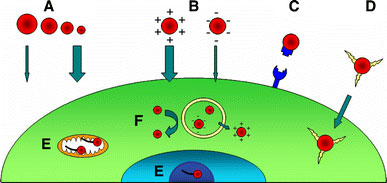Figure 1.

Factors affecting nanoparticle uptake. (A) Generally, smaller nanoparticles are internalized more efficiently than larger ones with similar surface characteristics. (B) Due to the negative charge of the cellular membrane, positively charged particles are preferentially taken up by living cells. (C) Cell-specific targeting by conjugating ligands for surface receptors to nanoparticles. (D) Rapid uptake and endosome bypassing can be achieved by conjugating protein transduction domains to the surface of the nanoparticle. (E) Conjugation of ODN was found to aid in specific subcellular localization based on the presence of complimentary cellular DNA. (F) Endosome escape has been reported to occur for nanoparticles whose surface is positively charged inside the low pH of late endosomes. Small nanoparticles have been reported to bypass degradation pathways better than larger particles of same chemical composition (see text for details)
